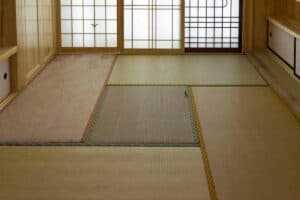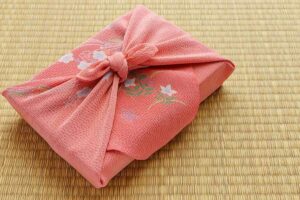If you have visited a traditional Japanese home or stayed at a Ryokan, you probably came across a Tatami mattress.
These comfortable rice straw beddings are usually standard and are laid on the floor in a particular pattern.
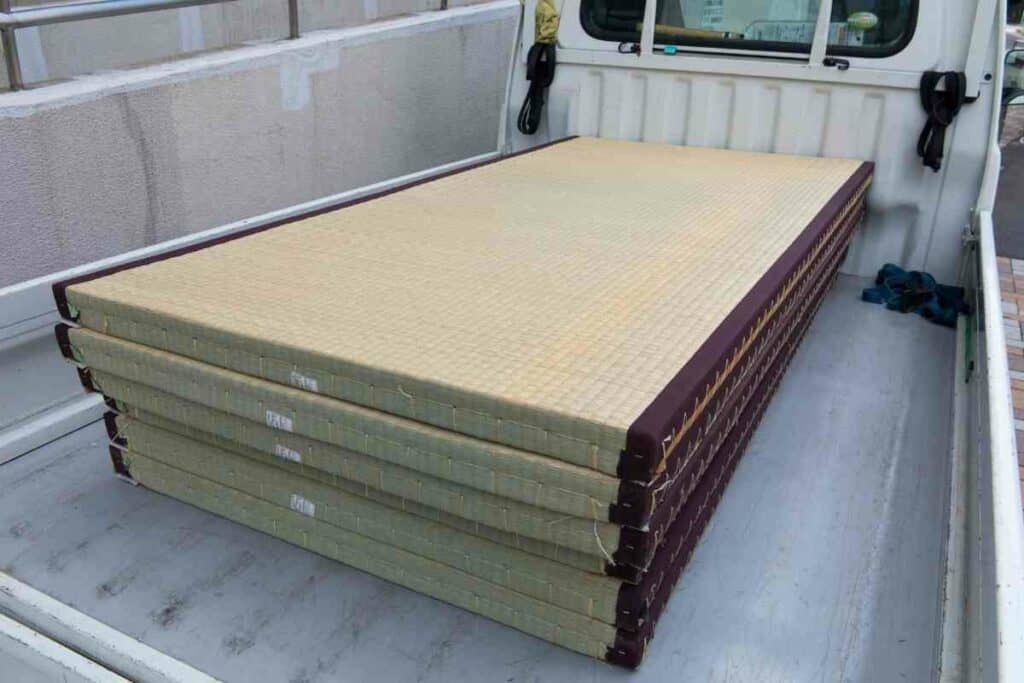
In traditional style Japanese bedrooms, they are a beneficial alternative to the modern high bed and mattress.
The sturdy natural rice straw material used to make Tatami mattresses has a distinct woody scent.
Popular in both old and modern Japan, the soft bedding, workout, or sitting area mattress is an intriguing product.
Are you still wondering what a tatami mattress is and what it is made from? Then, keep reading for detailed information about Tatami mattresses.
[lasso type=”table” id=”69″ link_id=”7648″]
Table of Contents
The history of the Tatami mattress
The earliest use of Tatami mats was for sleeping by noblemen and the elite, around 700 AD during the Nara period.
Later, in 1500 BC, they became popular as room flooring for various purposes.
In the 1700s, tatami mats were available in most Japanese homes, regardless of social status.
However, in recent years, their popularity reduced significantly, mainly due to their costly maintenance and replacement.
A few years back, finding a home with all floors in tatami was pretty rare.
Modern Japanese and people who love the culture are increasingly purchasing tatami mats for use in at least one room.
The original mats were thinner and easy to fold, whereas modern ones can be thick and large, depending on preference.
Additionally, the first tatami mats were made to lie on household wooden floors for sleeping or seating.
Today – The uses vary from homes and sports center to cafes and Japanese hotel rooms. An entire room can be tatami or small pieces in particular spots.
What size is the Tatami mattress?
At the height of their popularity in Japan, tatami mats became a way of measuring the size of a room.
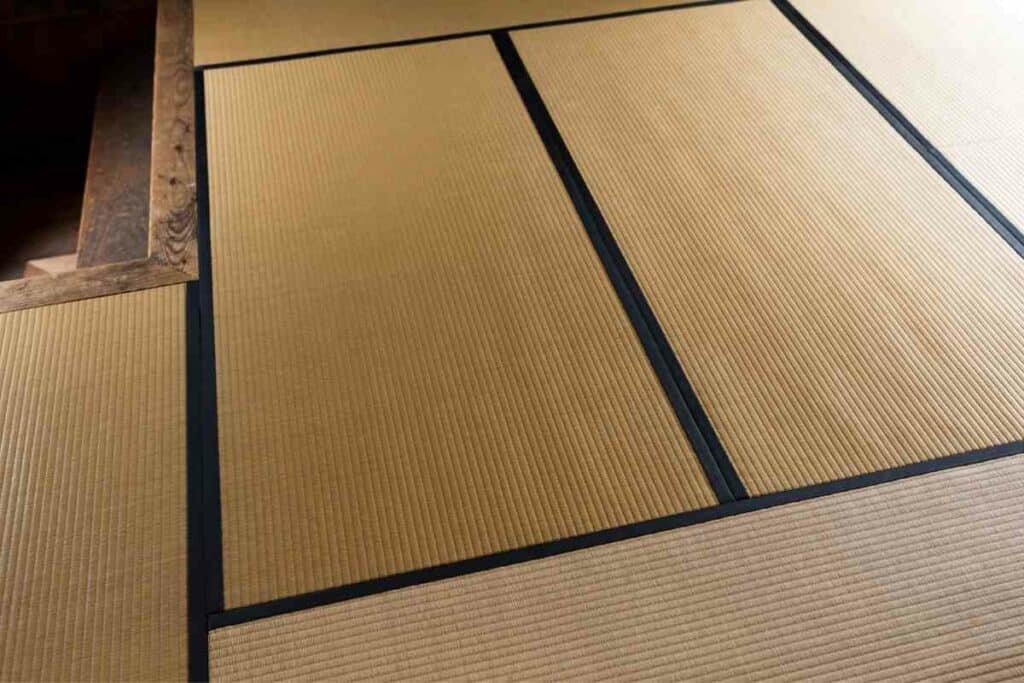
Instead of using the standard units of measure, feet or meters, Japanese people use Jo. Jo refers to the number of standard-size tatami mats that can fit into a room.
Depending on the region, tatami mats measure either:
- 0.88 by 1.76 meters (2.8 ft by 5.7 ft)
- or 0.95 by 1.91 meters (3.1 ft by 6.2 ft)
The thickness varies from 5 cm (1.96 inches) to almost 7 centimeters (2.8 inches).
The Jo measurement still stands among some architects and interior designers if one considers having a tatami room.
You can install full-length or half-length mats installed depending on the room size.
How Tatami mattress is made
A traditional tatami mat consists of a doko base, omote cover, and heri border in a rectangle.
First, the base, known as doko, is usually compressed into several layers of rice straw in a tight seal.
Then the cover, omote, made from a natural green rush known as igusa, is packed onto the base. Finally, the border known as heri is sewn around to hold the materials together.
The original rice straw base is authentic and lasts longer due to the natural materials.
However, modern tatami mat manufacturers use a mix of wooden chipboards and Styrofoam for synthetic products.
As a Result – Although modern tatami mats are affordable and strong, they are hard to sleep or walk on and may not last as long.
Tatami mattresses made using the natural rice straw base have varying quality ranks.
The best quality has the thickest smooth base and is reserved for temples, shrines, and Japanese tea rooms.
On the other hand, the following high-quality base is popularly used in wealthy homes. Lastly, lower grade bases are standard in traditional homes, apartments, and offices.
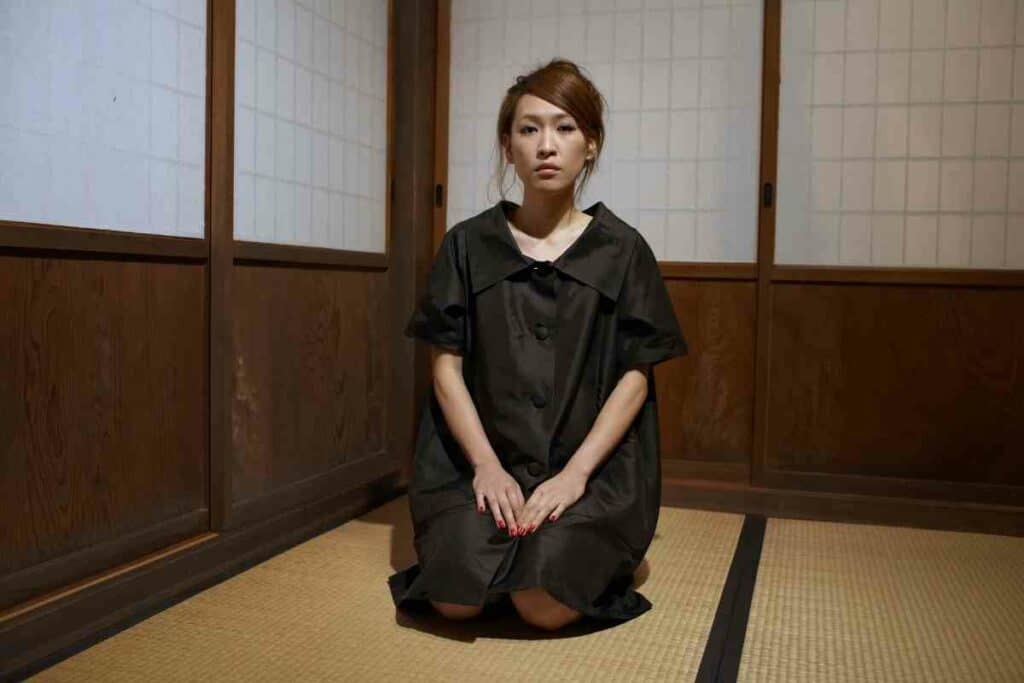
Weavers use cotton or hemp to weave around the igusa cover. The best quality igusa grown in Japan is light green and has a fresh grass smell.
However, as the mat ages, the color turns brown, and the smell disappears.
Tatami mats absorb sound and moisture and insulate temperature, making them a healthy addition to spaces.
Besides having a hemp or cotton border, the heri was also sewn out of silk for wealthy owners.
Now, the borders are of solid color from synthetic fibers, although some traditional mats retain the old Japanese patterns.
Tatami mats are supposed to last, so their material is similar to what makes traditional bags.
Laying out a Tatami mattress
In the conservative times, there were particular ways in which one would place tatami mats in a room.
As a result, different occasions and events require unique settings.
However, modern tatami arrangements ensure that two full mats’ four corners never meet with one another.
An ideal layout that will bring good luck is in a shape of a T.
However, for even-shaped patterns, one uses half-size mats to prevent them from forming a cross, which may signify lousy luck.
These shapes are, however, allowed if you are preparing a room during a mourning period.
Care instructions for Tatami mattress
Tatami mats last longer if proper care is maintained.
Since they are made of natural straw material, cleaning using a dry cloth is highly recommended.
If you use water, the drying straw may grow moldy and rot. Instead, use a vacuum cleaner to remove any collection of dust particles from the tight joints.
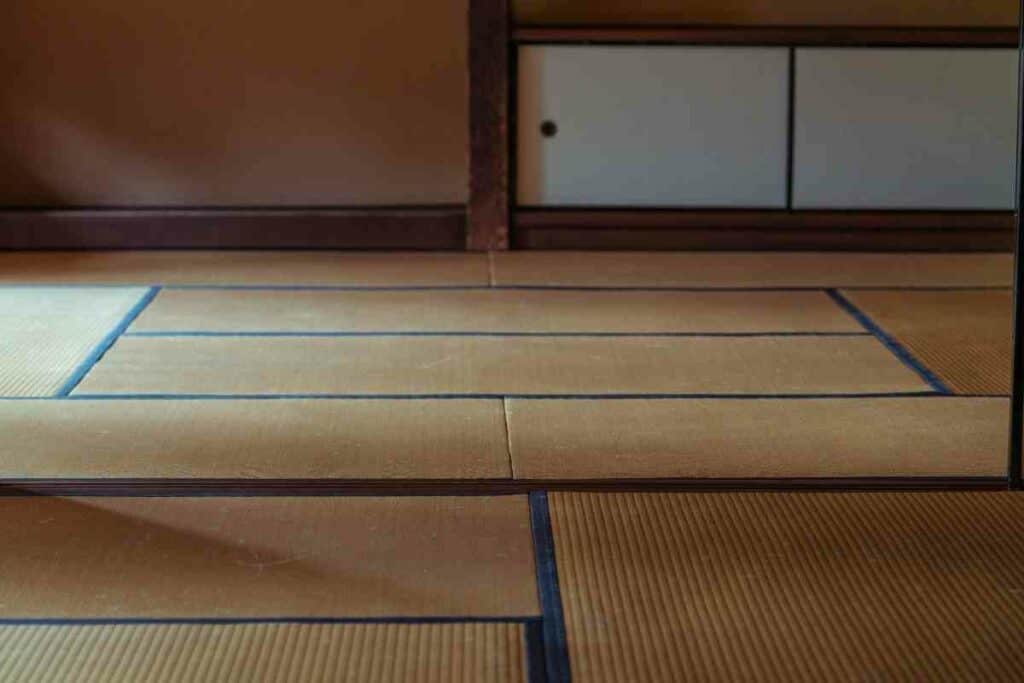
A well-maintained tatami mat will last over five years. The yellow shade it gets develops as the straw dries up with regular use.
Once it starts to look completely worn out and frayed, consider replacing it. Placing heavy items on the mats can also wear them out fast.
Always Good Idea – Most people also find a new tatami mat smell slightly unpleasant. Consider placing them in a well-ventilated room or air them out regularly to quickly reduce the new grass smell.
To prevent the rush from getting scuffed, ensure people remove their shoes before entering a tatami room. Lastly, only brush clean towards the grain and not against it to prevent damage.
The uses of Tatami mattress
Although most Japanese homes use tatami mats in traditional ways and rooms, modernization significantly changed things.
As a result, tatami mats are typical in wooden floor houses, though some western-style homes still have tatami rooms.
A traditional Japanese tatami mat room is known as a washitsu, and one can choose to have a mix of the old with the new.
Tatami rooms are excellent for kids’ play areas and soft floors to place a futon in the bedroom or sit on during the day.
Since they come in various sizes, one can get a tatami yoga mat or even small-size mats that are easy to fold away.
The large-sizes mats are ideal for use in a sleeping area or seating space. Whichever you choose, tatami mattresses have various benefits in a home, especially in a sleeping area.
Benefits of sleeping on a tatami mattress
It is common to find Japanese homes still use tatami mats as bedding.
They either lie on them directly or place a futon on top in modern households.
However, there are various benefits for those who want to use tatami mats for sleeping spaces.
These include:
- Sleeping on a flat tatami mattress may be suitable for your back. It improves blood circulation and helps alleviate back pain associated with poor posture. Regular mattresses are soft and easily take the shape of your body. Unlike firm tatami mats, which ensure your spine does not bend during sleep. Besides improving blood circulation in your body, your temperature remains the same if you sleep on the floor.
- They are excellent for small spaces. Tatami mats are easy to fold away, making them ideal for tiny homes with multi-functional spaces. For example, a standard bed permanently takes up almost half a room, while one must only roll a tatami mat away. If you want to save space or do not have enough, consider using tatami mattresses.
- They are an affordable alternative to regular mattresses. Tatami mats are affordable compared to modern mattresses. The highest quality bed mattresses will set you back thousands of dollars, including the bed frame.
- Easy cleaning. Lifting or rolling a tatami mattress to clean beneath it is simpler than working under bulky beds and mattresses.
- Improve the quality of sleep. People who use tatami mats to sleep on get better sleep as the natural smell of the straw relaxes the mind and body. If you have insomnia, consider sleeping on the floor on a tatami mattress.
Are there cons to using a Tatami mattress?
Although the pros to using a tatami mat are numerous, there are a few cons to consider.
They include:
- They are unsuitable for sleeping on the side. If you favor your side during sleep, sleeping on the floor adds pressure to your side joints. As a result, it may cause hip and shoulder aches due to the hard surface. Tatami mats are excellent for aligning the spine and are ideal for people who sleep on their back.
- They are not ideal if you have had a spinal injury, surgery, or chronic back condition. Also, sitting or standing up from the floor is difficult if you are unwell, so tatami mats may not be ideal.
- Trigger allergic reactions. People with allergies to grass may find it challenging to stay in a new tatami room. Additionally, since the mats stay on the floor, they may collect dust, causing problems for those with dust allergies. If you still prefer a tatami mat and have respiratory challenges, ensure it is always clean and the room receives adequate ventilation.
Where can I get a Tatami mattress?
You can have a traditional rice straw tatami mattress hand-made by artisans who still make them in Japan.
Alternatively, synthetic tatami mattresses are mostly machine-made and are available in various physical and online stores.
While in Japan, walk into a store to make your purchase or order online from anywhere.
New hand-made natural fiber tatami mats range in price from 50,000 yen to above 100,000 yen.
However, synthetic machine-made tatami mats are cheaper at around 8,000 yen to below 50,000 yen a piece.
Conclusion
The rich tradition of tatami mattresses results in an eco-friendly product and produces numerous benefits for the body and mind.
So get yourself one and experience first-hand the natural calming and cozy effect of a traditional Japanese Tatami mattress.
- 7 Best Japanese Sunscreen Products You Can Buy Online
- 5 Best Japanese Makeup Brushes for a Flawless Finish
- 7 Benefits Of Tatami Mats You Should Know
- The Best Furoshiki Wrapping Cloths: Inspiration, Ideas & Cloths You Can Buy
- Cool Tenugui Towels (10 Best Ones with Bold Japanese designs)
- Japanese Yukata Ideas & Inspiration (20 Creative Ideas)



